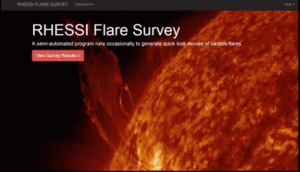RHESSI Flare List
RHESSI flares are identified autonomously during quicklook processing. Candidate flare intervals are determined by comparing the observing summary count rate in the 6 to 12 keV energy band to a threshold rate. A complete description of the algorithm for verifying the solar origin of the flare, and determining the parameters given in the flare list is given here.
The 'final' RHESSI flare list was generated and put online 18-Sep-2022. This version of the list takes advantage of the improved aspect solution using the final verified roll angle database for the full mission that was completed in August 2021. In addition, the count rate threshold for defining a flare is lower, only detector front segment data are used, and the amount of flare-splitting is reduced. The changes in the final list are described here.
In addition to the full text file linked to above, the flare list is available online in the form of monthly FITS and text files at Goddard (SDAC or hesperia) and Glasgow in the dbase directory. The text and FITS files are also distributed via SSW updates in the $SSW/hessi/dbase directory.
IDL routines to use the flare list are described here. In particular, note hsi_read_flarelist, used to read the entire flare list, and hsi_get_concat_flares, used to read the entire flare list and concatenate flares that are likely the same flare (contiguous in time, same approximate location).
Please note:
- Only events with non-zero position and energy range above 3 to 6 keV are confirmed as solar sources.
- The flare catalog is occasionally reprocessed (e.g. the 18-Sep-2022 update mentioned above, and the 10-Sep-2010 update to include ~24,000 microflares by using the 6 to 12 keV instead of the 12 to 25 keV band), so the start/end times for specific flares may change, and the number of flares on any day may change.
- Be careful when performing statistical studies of the RHESSI solar flares because flares are listed as multiple flares when interrupted by night, SAA, or gaps.
- Using hsi_get_concat_flares (mentioned above) to read the flare list is preferable to using hsi_read_flarelist.
- At the bottom of the text list, there are notes explaining the columns and flags in the list.
RHESSI Flare Survey NEW February 2014!
Lists of flares that meet different selection criteria with links to quicklook lightcurves and images.




